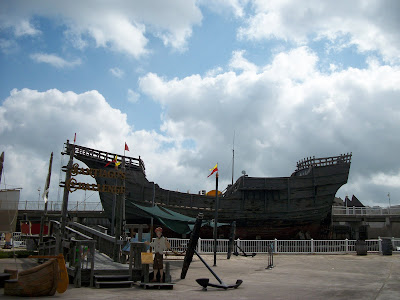During Spain's Golden Age (1500-1700), theater became the dominant form of entertainment. At first, itinerant actors performed on temporary stages set up in plazas. People lucky enough to live next to these plazas could either watch the performances for free or rent out their balconies. With time, this arrangement became more permanent, as theater companies enclosed the plazas and built permanent stages and seating. The neighbors still had the option of watching from their balconies or renting them out. This more permanent type of the theater space was called a corral de comedias, and soon every major town and city in Spain had one. Unfortunately, they were largely constructed of wood. When eighteenth-century moralists and arbiters of "good taste" drove the theater companies out of business, no one thought to preserve these basically makeshift theaters. Some, like the Corral del Príncipe in Madrid, were simply replaced with more modern, Italian-style theaters. Most were torn down or left to decay. The one in Almagro was adapted as an inn, and later built over until it fell into oblivion. Its ruins were discovered in the twentieth century. Fortunately, the people of Almagro had the foresight to restore it to its former splendor. Here is a view of the stage:
Except for the stage lights, it is quite authentic. Seventeenth-century stages didn't have a curtain, but actors could make use of the discovery space at the back of the stage and balcony above it. It was deeply moving for me to be able to stand in the kind of space for which playwrights like Lope de Vega, Tirso de Molina, and Pedro Calderón de la Barca wrote their works.
Seventeenth-century seating arrangements were as stratified as the society as whole, as can be seen in this picture taken from the stage:
The groundlings (mosqueteros) stood on the sides near the stage, while the somewhat more affluent paid to sit in the center. Regardless of wealth, however, no women were allowed on the ground floor. They had to enter by a separate door leading directly to the balcony, known as the cazuela (stewpot). Men were prohibited from entering this area, but occasionally an adventurous youth would cross-dress in order to have the opportunity to whisper into his beloved's ear during a play.
As mentioned above, corrales were generally built between existing buildings, so often the only seating on the sides was available from the balconies of private residences. Sometimes, however, there were side balconies built specifically for theater seating, as in Almagro. This area was known as the desván. It is where dignitaries, clerics, and critics sat:
This restored corral is used today as a working theater, and is the primary venue for the Almagro International Classical Theater Festival held each summer. It is therefore fitting that Spain's National Theater Museum is also located in Almagro. Although photographs were not permitted inside the museum, I was able to take pictures of some of the stage equipment on display in the theater's courtyard. Here is a machine used for simulating battle or storm sounds:
Here is a mechanical waterfall:
Theater is obviously central to Almagro's tourist industry, but I am glad that it brought me there. It is a truly beautiful and peaceful little town worth visiting anyway.
As we arrived into town, I overheard the taxi driver receive a radio message from a friend inviting him to lunch. The driver explained that he couldn't because he was in Almagro, to which the friend exclaimed how jealous he was that he wasn't there to see that beautiful little plaza. I can say that having our evening tapas in that plaza was among our most pleasurable experiences in Spain.



























































